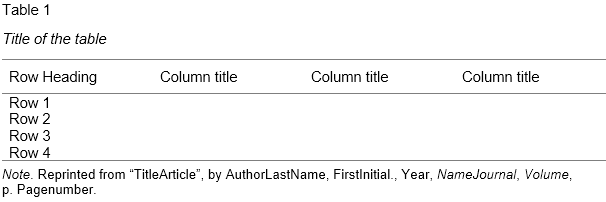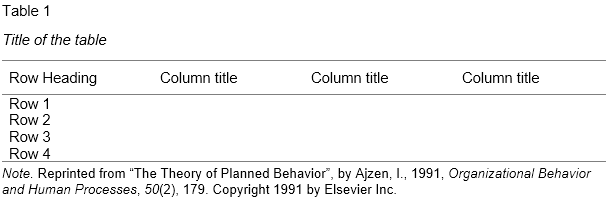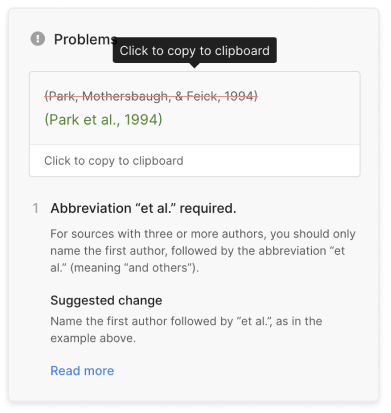Using tables and figures from other sources in APA Style (6th edition)
When you use a table, figure, or graphic from someone else, APA Style treats it as a quote. You must indicate the source in a note attached directly to the table or figure, as well as including a standard APA 6 in-text citation and reference list entry.
Treat tables, figures and graphics like quotes
When an existing table, figure or other graphic (such as a chart or picture) is taken from another source (possibly with adaptations), it becomes an image. APA style says it should be treated as a quote.
If the item is a table, you do not need to apply APA format for tables in this case.
An example of referring to a reproduced table in the text
The results in Table 1 (Ajzen, 1991, p. 179), show that…
As you can see, the author, date and page number of the source are included, just as in “normal” quotes. You should also refer to the complete source in the reference list.
An example of referring to a reproduced table in the reference list
Ajzen, I. (1991). The Theory of Planned Behavior. Organizational Behavior and Human Processes, 50(2), 179.
Notes
If you have copied a table, figure or other graphic from another source, you must indicate the source in a note that is attached to that item.
The APA style says you need to include “Reprinted from” or “Adapted from” followed by the title of the book or article and complete source information.
| Type table, figure or graphic | Description in the note |
|---|---|
| Copied exactly | “Reprinted from” |
| Copied with some adjustments | “Adapted from” |
Adding more clarification in the note
You can also use the note to provide information that clarifies the table, figure or graphic. For example, for a table you could comment on p-values, explain abbreviations or add details concerning a specific row or column.
Table, figure or graphic from an internet source
| APA format | Note. Reprinted from “ArticleTitle”, by AuthorLastName, Initials., (Year, Month Day). Retrieved from http://WebAddress |
| Note as to table | Note. Reprinted from “U.S. flood risk could be worse than we thought”, by Worland, J. 2015, July 27. Retrieved from http://time.com/3973256/flooding-risk-coastal-cities/ |
| In the reference list | Worland, J. (2015, July 27). U.S. flood risk could be worse than we thought. Retrieved from http://time.com/3973256/flooding-risk-coastal-cities/ |
Table, figure or graphic from a journal
| APA format | Note. Reprinted from “ArticleTitle”, by AuthorLastName, Initials., Year, NameJournal, Volume, p. Pagenumber. |
| Note as to table | Note. Reprinted from “The Theory of Planned Behavior”, by Ajzen, I., 1991, Organizational Behavior and Human Decision Processes, 50(2), p. 179. |
| In the reference list | Ajzen, I. (1991). The Theory of Planned Behavior. Organizational Behavior and Human Processes, 50(2), 179. |
Table, figure or graphic from a book
| APA format | Note. Reprinted from “BookTitle”, by AuthorLastName, Initials., Year, p. Pagenumber, City, State/Country: Publisher. |
| Note as to table | Note. Reprinted from “The Harvard Medical School Guide To Men’s Health”, by Simon, H. B., 2002, p. 107, New York, NY: Free Press. |
| In the reference list | Simon, H. B. (2002). The Harvard Medical School Guide To Men’s Health. New York, NY: Free Press. |
Copyright
The APA style indicates that when a table, figure or graphic from another source is used, the copyright of the item’s owner should be mentioned in the note. This is especially important if you plan to publish your text.
You should refer to the copyright at the end of the note:
| APA format | Note. Reprinted from “ArticleTitle”, by AuthorLastName, Initials., Year, NameJournal, Volume, p. Pagenumber. Copyright Year by Publisher. |
Table Copyright
Sources in this article
We strongly encourage students to use sources in their work. You can cite our article (APA Style) or take a deep dive into the articles below.
This Scribbr articleSwaen, T. (June 16, 2022). Using tables and figures from other sources in APA Style (6th edition). Scribbr. Retrieved October 17, 2022, from https://www.scribbr.com/apa-style/6th-edition/archived-using-tables-figures-sources/




